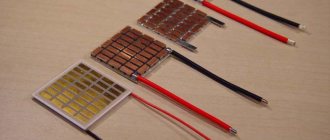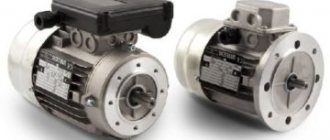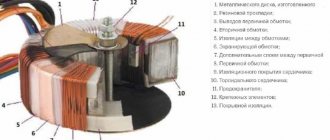An electric current passing through dissimilar metals in contact with each other causes their electrons to move differently and, accordingly, to heat up or cool from different sides.
This discovery, formulated in the 19th century, is still used today (for cooling working parts in video adapters, computers, portable refrigerators).
Today you can buy a wood-burning electric generator, the operation of which is based on the discoveries of scientists Seebeck and Peltier. What is interesting about this generator, how it works and where it is used. More details about everything.
How it works?
A standard Peltier element is a plate with two outputs for connecting to the network, assembled from cubes of different metals, for example copper and constantan, copper and nickel, lead and constantan, etc.
The plate passes electric current through itself and heats up on one side, and on the other hand it becomes cold.
The presented electric generator uses the opposite principle: one side of the element is heated by burning fuel (in this case, wood chips and firewood), the other is cooled by any heat exchanger - liquid or air, and a constant electric current is generated on the wires, which can already be used at your discretion.
One cannot expect high power levels; even in factory furnace-generators (they usually have two elements), up to 60 W are generated. Homemade ones typically output 5 W (enough to charge a cell phone or power an LED flashlight).
The electric current in such a stove is only a by-product; the main energy from the combustion of wood is not wasted, but is used to heat the room (enough for a small house, cottage or tent).
Electricity from biomass, or “people's” electric generator
The electrical topic is one of the most popular and discussed on our portal. Everyone needs light: both those who are just starting to build, and suburban residents who have already settled in their plots. But electricity tends to periodically “disappear.” A broken wire, a power outage, or simply not enough “light” for everyone. There are many reasons. The problem is aggravated by the fact that all engineering systems in the house depend on a reliable and uninterrupted supply of electricity.
We have already told our readers how to independently make a backup power supply system for a country house. It is all the more interesting to find out how they approach solving this problem abroad.
At first glance, it seems that “there” everything is definitely in order. Not at all. Another workshop disconnection from the city power grid forced California resident Jim Mason to look at the problem from a different angle. He began searching for an alternative source of power that would once and for all help him gain independence from the city authorities. Ten years of hard work, the founding of his own company, and a compact gas generator was born that generates electricity from woody biomass.
The current is generated as follows. Biomass is placed in the combustion bunker of the device. This can be crushed wood waste, seed husks, nut shells, sawdust, etc. Next, the fuel is “driven” into a long-term smoldering mode. As a result of the slow combustion of biomass, wood gas is released during its thermal decomposition (pyrolysis). The resulting gaseous fuel is used to operate a three-liter, four-cylinder internal combustion engine, which, in turn, drives a generator that produces electric current.
The gas-generating power plant can produce both single-, two- and three-phase alternating current with voltage from 120 to 480V. The operation of the power plant is fully automated and requires minimal human intervention. The user just needs to load biomass fuel into the bunker and remove the ash from a special automatic storage tank once a day.
To generate 1 kW of electricity, the installation consumes 1.5 kg of biomass. The level of power generated largely depends on the type of fuel loaded into the bunker, because the volume of gas produced depends on the condition of the biomass, the degree of its drying, etc.
Engineers emphasize that the installation is not designed to operate on coal, municipal solid waste, recycled tires, or plastic waste.
Due to the mobility and relatively light weight of the unit, it can be transported on a trailer or in the back of a pickup truck. By combining several installations, you can assemble a power plant to supply energy to a small settlement. As an option for installation, a device connected to the engine cooling radiator is offered. Due to this, thermal energy is “removed”, which is then used to heat water in the hot water system. The installation can also be combined with other energy sources, including alternative ones.
Field tests of the installation were carried out in West Africa, and it fully proved its performance in hot climates. According to experts, the installation will be useful for farmers, owners of small woodworking industries, land and homeowners who want to have a powerful and compact source of electricity and not depend on energy companies.
And our video talks about how an inverter and battery bank can increase the electrical power in your home.
Source
Peculiarities
Indigirka is a multifunctional device, which is a symbiosis of a long-burning wood stove and a thermal electric generator capable of producing electricity.
The compact and lightweight stove can be easily transported and installed not only indoors, but also used outdoors. The device can operate at temperatures from +40 to -30 ° C.
The spacious hob can accommodate several types of cookware (cook soup, heat tea, etc.). The electricity generated by the stove is quite enough to connect a portable TV, radio, 1-2 light bulbs, and charge the power supply of a mobile phone, laptop or video camera.
Operating principle of wood gas generators
Burning wood quickly in the open air produces mainly some useful heat. But wood behaves completely differently during so-called pyrolysis combustion, i.e. when burning in the presence of very little oxygen.
In such a situation, it is not so much combustion that is observed, but rather smoldering of the wood. And the useful product of this process is not heat, but flammable gas.
Gas generators were once actively used as a fuel supplier for cars. And now you can occasionally find cars that run on the gas they produce:
When wood burns slowly, the output is a mixture containing the following products:
Only part of these ingredients are flammable gases, the rest is pollution or non-flammable ballast, which is better to get rid of. Therefore, it is necessary not only to burn the wood in a special installation, but also to purify the result, and also to cool the resulting gas mixture.
In industrial production conditions, this process includes the following steps:
Homemade devices for home use look simpler and take up less space, but the principle of their operation, as well as the design, are very similar. Before starting the manufacture of such a device, you need to think everything through carefully, and also draw up or find a design for the unit.
There are many recommendations on the Internet on how to make a homemade wood gas generator. Some of them are equipped with drawings that are quite realistic for implementation.
Masters who have already managed to carry out this fascinating process to some extent note that it can take a lot of time and effort. It may be necessary to perform more than one alteration and carry out a number of experiments in order to obtain a unit with acceptable characteristics.
Classic version
As noted, a wood-fired power plant uses several technologies to produce electricity. The classic one among them is steam power, or simply the steam engine.
Everything is simple here - wood or any other fuel, when burned, heats up the water, as a result of which it turns into a gaseous state - steam.
The resulting steam is supplied to the turbine of the generating set, and due to rotation, the generator generates electricity.
Since the steam engine and generator set are connected in a single closed circuit, after passing through the turbine the steam is cooled, fed back into the boiler, and the whole process is repeated.
This power plant scheme is one of the simplest, but it has a number of significant disadvantages, one of which is the danger of explosion.
After water passes into a gaseous state, the pressure in the circuit increases significantly, and if it is not regulated, there is a high probability of rupture of the pipelines.
And although modern systems use a whole set of valves that regulate pressure, the operation of a steam engine still requires constant monitoring.
In addition, ordinary water used in this engine can cause scale to form on the walls of the pipes, which reduces the efficiency of the station (scale impairs heat transfer and reduces the throughput of the pipes).
But now this problem is solved by using distilled water, liquids, purified impurities that precipitate, or special gases.
But on the other hand, this power plant can perform another function - to heat the room.
Everything is simple here - after performing its function (rotation of the turbine), the steam must be cooled so that it turns into a liquid state again, which requires a cooling system or, simply, a radiator.
And if you place this radiator indoors, then in the end we will receive not only electricity from such a station, but also heat.
Advantages and disadvantages
A gas generator that runs on wood has a lot of positive characteristics and not too many disadvantages. First, let's talk about the benefits.
High efficiency. This indicator for gas generators remains at 90%, which is quite good. For comparison, solid fuel boilers have an efficiency of 75%. A number of models are equipped with automated combustion process control mechanisms. The fuel burns completely. One stack of firewood provides up to a day of operation of such a device. And if you use coal instead of firewood, then the stash may last for several days. Firewood usually burns completely, leaving very little ash behind. For this reason, you will not have to clean the device often. Any solid fuel can be used as fuel. Even long firewood can be thrown into the combustion chamber, which means there is no need to cut it into small chips. The release of harmful substances during operation of the device will be minimal
For this reason, a number of motorists paid attention to such devices. Significant monetary savings on fuel.
If we talk about the disadvantages of wood-burning gas generators, then there are only three of them.
- Models made at the factory have a high cost.
- Condensation sometimes forms inside the chimney. To avoid its formation, the temperature inside the gas generator should be 60 degrees.
- Most models have fans at the air outlet inside the air separation compartment. They can be operated manually, but some models require electricity to operate, making the gas generator dependent on electricity.
Engineering capabilities
The technical characteristics of power generating equipment speak for themselves:
- the optimal amount of fuel for loading is 30 liters;
- external dimensions have the following parameters: height – 652 mm, depth – 427 mm, width – 540 mm;
- unit weight – 54 kg;
- the maximum size of a heated structure is 50 m³;
- chimney diameter – 80.0 mm;
- the smallest chimney height is 3.0 meters;
- number of chimney pipes - 9 pieces per set;
- combustion compartment – 41 dm³;
- thermal power – 4 kW;
- output power – 50 W (min);
- output voltage – approximately 12 Volts;
- firebox door size – 178 mm in diameter;
- heating surface – 0.6 sq. m;
- type of fuel - brown coal, peat, firewood from deciduous trees, fuel briquettes, pallets.
It is important to know: it is strictly forbidden to use coal as a combustible material.
Valuable information on gas generators
Sometimes the expectations of private home owners who are thinking about purchasing or making a gas generator themselves turn out to be too rosy compared to the real situation.
There is an opinion that the efficiency of the gas generator, which is about 95%, significantly exceeds the efficiency of a conventional floor-standing gas boiler, which reaches 60-70%. These figures are generally correct, but it is incorrect to compare them.
The first indicator reflects the efficiency of production of combustible gas, and the second - the amount of heat obtained during operation of the boiler. In both cases, wood burns, but the result of this process is qualitatively different. If in the future the combustible gas obtained by pyrolysis combustion of wood is used to heat a home, such a comparison can be made.
It is also worth remembering that homemade gas generators, although they can work with high efficiency, are rarely as effective as industrial models. This point should be taken into account at the stage of designing the unit and calculating the cost of the project and its expected efficiency.
If the need to create a gas generator is due only to the desire to improve the heating system at home, you should pay attention to a similar device - a pyrolysis boiler, which operates on very similar principles. Its main difference from a gas generator is that the resulting gas is immediately burned, and the resulting energy is used to heat the coolant in the home heating system.
In such a device, an additional combustion chamber is installed, into which it is necessary to organize a separate air supply. If you need to heat the house using a gas generator, you will also need to choose a convector for heating. This will increase the cost of upgrading or installing heating. It is necessary to calculate whether in this case the game is worth the candle?
An important point is proper maintenance of the gas generator during its operation. Advertising claims that this is a universal device in which everything burns: from sawdust to freshly cut wood.
But the advertisement is silent about the fact that when loading wet raw materials, the amount of combustible gas produced can be reduced by 25% or more.
The optimal fuel for a gas generator, according to experts, is charcoal. When it burns, a minimal amount of energy is consumed to evaporate moisture, which allows the pyrolysis process to be accelerated.
Vehicle owners can count on a gas generator not only for heating, but also for the operation of their vehicle. Indeed, in Europe, many motorists have quite successfully adapted their vehicles to run on wood. But most often these are compact and durable devices made of thin and durable stainless steel.
The cost of such units, even those made independently, is not at all small. In Russian realities, gas generators for cars are made from improvised materials and installed on trucks.
The effect of their operation is low; usually the presence of such a unit is accompanied by such phenomena as prolonged ignition, the need to constantly operate the engine at high or medium speeds, which contributes to its rapid wear.
An interesting option for using a gas generator in private households is the use of combustible gas for a home power plant. Such a project is being implemented using a diesel internal combustion engine.
Thermoelectric generators
Power plants with generators built according to the Peltier principle are quite an interesting option.
Physicist Peltier discovered an effect that boils down to the fact that when electricity is passed through conductors consisting of two dissimilar materials, heat is absorbed at one of the contacts, and heat is released at the other.
Moreover, this effect is the opposite - if the conductor is heated on one side and cooled on the other, then electricity will be generated in it.
It is the opposite effect that is used in wood-fired power plants. When burned, they heat up one half of the plate (it is a thermoelectric generator), consisting of cubes made of different metals, and the second part is cooled (for which heat exchangers are used), as a result of which electricity appears at the terminals of the plate.
But such a generator has several nuances. One of them is that the parameters of the released energy directly depend on the temperature difference at the ends of the plate, therefore, to equalize and stabilize them, it is necessary to use a voltage regulator.
The second nuance is that the energy released is just a side effect; most of the energy when burning wood is simply converted into heat. Because of this, the efficiency of this type of station is not very high.
We recommend: How to choose the right insulation for heating pipes
The advantages of power plants with thermoelectric generators include:
- Long service life (no moving parts);
- At the same time, not only energy is generated, but also heat, which can be used for heating or cooking;
- Quiet operation.
Wood-burning power plants using the Peltier principle are a fairly common option, and they produce both portable devices that can only release electricity to charge low-power consumers (phones, flashlights), and industrial ones that can power powerful units.
Briefly about the main thing
Modern models of wood-burning gas generators are so effective that they can even be installed on a car. However, in most cases, it is a successful way to save on fuel for remote areas where, apart from firewood, there are no other types of energy resources, and delivering them there is unprofitable. Simplified, the unit consists of a housing, a loading chamber, a firebox and an ash pan. Its operating principle is based on the thermal decomposition of wood or coal at low oxygen levels, and subsequent reduction to carbon monoxide and hydrogen.
Flue gases are cooled, purified and mixed with oxygen before entering the internal combustion engine. The main advantages of gas generators of this type:
- Great efficiency.
- Up to 25 hours of burning per load.
- Complete burning of wood.
- Power adjustment.
- No harmful emissions.
- Economical.
- Possibility of using raw wood.
- Operation on other types of fuel.
- Safety.
- Large chamber volumes.
The disadvantages are manifested in the high cost, energy dependence of modern models, the possibility of clogging, gas temperature control, manual loading, and the need to use dry fuel. In this case, there are 3 varieties - direct, reverse and horizontal. Each of them has its own pros, cons and application features. The installation of the unit must be carried out in accordance with the regulations.
Description and design characteristics
The Indigirka heating, electricity-generating cooking stove is a simple but unique design consisting of the following elements:
- The firebox is made of heat-resistant stainless high-alloy steel (2.0 mm thick). Due to this, the air space of the object quickly warms up. The maximum volume of a heated room does not exceed 50 cubic meters. Elements not subject to temperature stress are made of one and a half millimeter structural steel.
- There are 2 thermal electric generators (TEG) 30-12 fixed on the side walls of the firebox. Using a cable, connectors for connecting electrical appliances are connected to the generator. Generators transform the heat of burning fuel into electrical energy. A stable, full-fledged operation mode of the TEG begins 10 minutes after the fuel is ignited.
- The firebox door can open 140 degrees. A window made of heat-resistant glass is mounted on the door, through which the fuel combustion process is visually observed.
- The grate is made of heat-resistant steel alloy. Through the grate slits, ash and combustion product residues enter the movable ash pan. The model is equipped with a valve that regulates the intensity of the combustion process. The ideal fuel for a TEG stove is firewood, peat and wood chip briquettes.
- The upper part of the body is designed for heating and cooking food.
The outer surface of the Indigirka stove is covered with silicone heat-resistant enamel.
Please note: before continuous operation of the heating device, it is recommended to pre-fire the stove in the open air for an hour to eliminate the smell and smoke emitted by the enamel.
Design and principle of operation
The device in question has a simple design, because all the processes that occur inside it are based on pyrolysis-type combustion. That is, the operating principle will be the same as in pyrolysis boilers, in which wood burns when there is a lack of oxygen, releasing many different gases. A wood-burning gas generator consists of the following elements:
- bunker;
- housings;
- combustion chambers;
- loading hatches;
- grate type grates.
Now let's talk about them in a little more detail. The body is usually made of sheet steel and is either rectangular or cylindrical in shape. The legs are welded to it from below. If we talk about the bunker, this element is also made of sheet steel, which contains little carbon. It is usually cylindrical or rectangular. It is inserted inside the case and attached to its walls with screws. There must also be a lid that will cover the top hole leading to the bunker. Asbestos is usually used as a sealant.
The combustion compartment is located at the bottom and is made of steel, which contains a lot of chromium. This is where solid fuel combustion occurs with insufficient air. Asbestos cords are usually located between the internal parts of the housing and this element. And on the walls on the sides there are tuyeres for oxygen access, through which it is supplied to the combustion chamber. The tuyeres are connected to an air distribution tank, which communicates with the environment. When oxygen comes out, it overcomes the check valve. It is necessary to block the release of gas formed during firewood combustion into the atmosphere.
The grate is usually located at the bottom of the gas generator. It must keep the fuel hot. In addition, through special holes, the ash that is formed during the burning of wood ends up in the ash pan.
If we talk about loading hatches, the device usually has three of them. The first one is installed at the top and its lid opens horizontally. The already mentioned asbestos cords are used for sealing. By the way, modern devices are equipped with a special shock-absorbing spring at the location where the hatch is attached, which automatically works if the pressure inside the gas generator exceeds a certain level. And under its action the hatch simply opens.
The second hatch is located at the level of the recovery area, and fuel is loaded into it. And the third hatch will be located at the bottom of the generator next to the ash pan. It will be used for cleaning.
If we talk about the principle of operation, then first the fuel enters the drying zone. It is located at the top of the device under the loading hatch. Here the fuel is dried at a temperature of almost 200 degrees.
After this, the fuel enters the dry distillation area, which is located below. Here the already dried fuel is charred, because the temperature will be 2 times higher and amount to 500 degrees.
Next, the fuel enters the combustion area, which is located even lower. Here it burns completely under the influence of a temperature of 1200 degrees. It is here that oxygen is supplied through special lances. During combustion, carbon dioxide and carbon monoxide are released.
The last one will be the recovery zone. Here the gases that were released earlier rise and enter this zone. Coal is placed here through a special hatch, held on the grate. The gases react with the coal to create carbon monoxide. But coal contains water, which also results in the formation of hydrogen, methane, nitrogen and a number of hydrocarbon-type compounds.
Pros of this generator
The simpler the design, the more reliable it is, this can also be said about the type of electricity generation presented.
There are no parts rubbing against each other that could fail. Therefore, a wood-burning generator:
- durable and reliable;
- works silently;
- uses available fuel;
- lightweight, portable - can be up to 1 kg.
The generator furnace is a know-how of recent years. It will be of interest to both amateur experimenters and travelers, fans of hiking and fishing. And who wouldn’t want to have access to electricity during a blackout?
For a homemade stove, all the parts can be bought very inexpensively - within 500 rubles. (Chinese Peltier elements can be ordered via the Internet for about 300 rubles.)
We extract wood gas and run a generator on it
The principle of formation of flammable gas is very simple. If you put firewood in a sealed container where oxygen does not enter, and then heat the fuel from the outside, it will begin to smoke, and smoke is nothing more than evaporation. Of course, ordinary smoke from a fire is not flammable, because everything that could burn there has already burned in the fire. Our smoke, which will come out of the furnace, will contain a lot of flammable resins and other compounds.
This fuel can easily power an internal combustion engine, be used to power a burner, and so on. So, let's look in more detail at how to conduct such an experiment.
An electric motor is connected to the shaft of the internal combustion engine. It is used as a starter and then as a generator. The whole thing starts with a 12V battery. An inverter is connected to the generator, with which you can raise the voltage to 220V and connect various household appliances. The author decided to connect a light bulb for demonstration.
Materials and tools that the author used to make the gas generator:
List of materials:
- old metal canister; - a piece of pipe; - a metal jar with a sealed lid; — copper tube (for the heat exchanger); — various water fittings; - two jars with sealed steel lids; — rubber hoses; — a tap and a piece of metal pipe (for the burner); — tee for hoses; - self-tapping screws; - cold welding; - thin sheet steel.
Device manufacturing process:
Step one. Let's start with the oven
The oven consists of two chambers, internal and external. Fuel is poured into the internal one, which is then converted into flammable gas; this container is hermetically sealed. As for the outer part, fuel is placed and burned in it, which heats the central container with firewood.
First of all, you will need a metal canister or something similar. The author cuts off the neck of the canister with a grinder and screws it to the base, as a result we get a kind of pallet that will not allow the wooden base to catch fire. We place the cut canister on top.
Step two. Installing “banks”
Place two cans on the platform; the author secures them with self-tapping screws. One of the cans is the heat exchanger housing, and the second is the filter housing. Take one of the covers and drill holes. They are equipped with a fitting for connecting a hose and a fitting for connecting a copper pipe of the heat exchanger.
Criterias of choice
Due to the fact that the wood-burning autonomous electric generator exists in several versions, the user’s choice is simplified. Since only a generator stove is suitable for the home, there are no other options. And large wood-burning power plants are used to supply power to industrial or civil facilities, since their power varies between 100-200 kW.
When choosing, you should take into account the size of the facility that will be served, as well as what power you should expect. To determine the amount of fuel consumption, you need to plan with what degree of efficiency and how often the device will be used, based on this, the volume of the loading container for firewood is selected.
Existing models
Fully functional, high-performance equipment such as the BioKIBOR power plant is quite expensive. If a wood-burning generator was chosen for the facility, then you can buy it within the amount of 2,000,000 rubles. By design, this is a modular installation with automatic fuel supply. To provide 100 kW equipment with firewood for one day, 5 tons (or 200 kg per hour of operation) will be required. The specified amount of fuel is required for full operation of the station.
Let's watch a video about the Indigirka wood-burning stove-generator model:
A device such as a wood-burning stove-generator (Indigirka brand Termofor) will cost the user approximately 30,000 rubles. When purchasing, the capacity of the combustion chamber is taken into account (41 liters), with a maximum load of 30 liters. To remove combustion products, a chimney is provided, the diameter of which is 80 mm and the height is 3 m. The output voltage is 12 V and the power is 60 W.
General recommendations
Wood-burning generator for charging your phone
To maintain a high temperature, it is necessary to ensure that there is enough fuel in the combustion chamber. If this is not necessary in the case of an automated power plant, then the furnace-generator does not have the function of autonomous fuel supply.
Such a device must be operated with a chimney that removes combustion products, especially if the operation is carried out indoors.
As an alternative to expensive equipment, you can make a backup electric generator using wood with your own hands. But this design also implies the use of a Peltier element. Without this, it is problematic to organize the conversion of temperature into electricity. According to users, a compact stove-generator is fully justified, especially in the context of the current decline in the price of such a unit and the availability of solid fuel.
Thus, the operation of a low-power household electric generator is an alternative to high-performance gasoline and diesel devices. But before purchasing, you should consider such a thing as the need to purchase an inverter to convert the output voltage of 12 V to 220 V. Without this, it will be impossible to connect most modern devices.
Installation Rules
When installing gas generating units using wood, it is recommended to follow the following rules:
- Installation of equipment is allowed anywhere in the house - basement, basement, room - as well as outdoors, subject to safety precautions and technical conditions.
- Models designed for loading long firewood are best installed outdoors near the fuel storage area.
- For installation inside the house, it is better to choose a generator that runs on pellets. Since their storage and operation does not involve the generation of waste.
- In the case of using flue gases for heating and minimal cooling, pipes to the house from a unit installed on the street are laid in thermal insulation and underground.
Recommendation! Gas generators exhibit maximum performance when fully loaded. However, the amount of energy generated can be excessive. Therefore, in order to preserve it, for example, for heating, it is necessary to use special heat-insulated containers - heat accumulators.
Model overview
You can buy a wood-burning electric generator from specialized companies.
Portable models
They are represented by wood chippers and grills equipped with an electrical converting element. This stove is good for heating food on a hike; you can use it to warm a mug of tea, fry a small piece of meat, and charge your gadgets at the same time. not designed for more .
For example, the BioLite CampStove stove can operate on any wood fuel: twigs, chips, cones. It produces up to 5 W of power and is equipped with USB. To boil a liter of water, just a little wood is enough, and it will take literally 5 minutes. The price of BioLite CampStove is 9,600 rubles .
Indigirka
The Indigirka stove is the most famous model of wood-burning electric generators. This stove heats a room up to 50 m3, weighs 37 kilograms, is made of heat-resistant steel and lasts for decades. Firebox volume – 30 liters. Indigirka's output voltage is 12 volts, maximum output power is 50 W. Of course, the main purpose of the stove is heating; a convenient cast-iron burner allows you to cook food or warm tea. As an electric generator, the stove is able to work within 15 minutes after ignition.
We recommend: Open heating system and closed one - which is better and what to choose?
Where can I buy?
- BioLite CampStove – can be purchased in the AvtoStudio online store. Tel.
- On the website ivenue.ru (9450 rub.) Delivery in Moscow.
- Icover PRO LLC
These three suppliers offer miniature burners - 5 kW wood chippers, which tourists can take on a hike and, while heating food on the fire, simultaneously charge the batteries of digital devices (cord with USB output).
Energy generating furnace Indigirka
The Termofor online store is a larger Indigirka oven. Its power is 50-60 kW, which heats the house, has a cast-iron “circle” for cooking and connectors: USB, cigarette lighter and “crocodiles”.
In Perm you can buy a thermoelectric generator B25-12 (a separate device, without a stove, for installation on a hot surface) - 25 W. Phone number for orders. – 15,000 rub.
During wartime, when there was a shortage of fuel, cars were made using wood. Now such generators are also used, but mainly for household needs. Do-it-yourself gas generator: step-by-step production of the unit and installation of equipment.
Which wall-mounted gas boiler is better to choose, read here. Prices and characteristics of devices.
Charcoal is used as fuel for baths and fireplaces, as well as for cooking barbecue. In addition, it is widely used in industrial applications. In this article https://microklimat.pro/otopitelnoe-oborudovanie/pechi/drevesnyj-ugol-svoimi-rukami.html you will learn how to make coal with your own hands. Let's consider several methods: in a barrel, in a pit and in an oven.
Method No. 1 - Do-it-yourself wood-burning electric generator
The basis of the device is a Peltier element. It can be purchased specially or removed from the computer (it is located between the processor and the heatsink).
In addition to this, for the unit to operate you will need:
- voltage stabilizer, also known as a module with USB output;
- metal for the case (you can use the case from an old power supply);
- cooling radiator and cooler;
- thermal paste;
- tools – riveter, metal scissors, drill;
- soldering iron;
- rivets.
First, the body of the wood chipper is made (on which you can boil water in a saucepan using small brushwood).
This is a square jar without a bottom, has holes for air on the bottom, and a stand on top for a container (although this is not necessary, the generator will work without water).
A Peltier element is attached to the side of the case, and a cooling radiator is attached to its cold side through thermal paste. It is important that the contact between the parts is as tight as possible. This creates the basis of a generator furnace.
The radiator must cool the system as best as possible, since the greatest efficiency is achieved with a large temperature difference. There will be no problems in winter, since the device can be placed in the snow. But in the warm season, the radiator will gradually heat up, so a cooler is installed to cool it.
Next is the electrical part. It’s good if you managed to find a voltage stabilizer in the same case with a USB socket - it will be convenient.
A stabilizer is needed to ensure that the output always has the specified voltage, regardless of how much the generating element produces.
You can purchase a ready-made one with a diode indicator that lights up when the voltage reaches a predetermined value.
The stabilizer and Peltier are soldered according to the poles. The stabilizer is carefully insulated to prevent any moisture from entering.
The design is ready, testing can be carried out.
Electricity from wood! Autonomous energy source for home
220 volts from wood. Thermoelectric generator. The main problem with using thermoelectric modules is the subtle temperature transition that is difficult to maintain. If installed correctly, you will not be able to cause destruction, given the constant heat dissipation by the radiator. Unless, of course, you burn it with coal, which is strictly prohibited due to the high combustion temperature and the danger of melting the metal. Moreover, this is not a new product; ready-made stoves have been sold for more than 10 years.
It is advisable to connect directly to the load through a stabilization unit. You can connect to batteries directly, but only through a diode. Otherwise, on a cold stove, you will heat up or remove heat back, depending on the polarity of the connection. Structurally, the product consists of five elements.
The first, thermal compensation and stabilizing, on hinges, serves to compensate for temperature deformations. (bending, geometry changes) with rapid or uneven heating. That is, being an independent part, without a rigid connection with the second element, it can change its geometry, but at the same time does not bend the second element to which the generating modules are pressed.
At the same time, it transfers heat to the neighboring element by contact, infrared and convection. In which the constant contact of the coolant with the generating module and then with the radiator is ensured, protecting the latter from mechanical destruction and maintaining good thermal contact.
In other words, if the design of the heated element were monolithic, the hot part would very significantly change its shape relative to the cooled radiator, the layer between which is the third element, the generating modules themselves. Simply, the modules would collapse or not reach the specified mode.
The fourth and fifth design elements are the radiator and fans, respectively. If a fan or two fails, you should stop the active firebox by closing the air flow. And wait until the oven cools down.
Source
Method No. 2 - Self-production
Self-assembly of such a model does not present any particular difficulties for craftsmen.
When creating a wood-burning electric generator with your own hands, you need to buy or remove a Peltier element from an old portable refrigerator. It looks like a thin-walled plate-like square. One of its panels is made of copper, the other of nickel. Contact clamps are attached to them, which are subsequently connected to the network. The principle of operation is that when current passes through metal surfaces, one side of the part heats up and the other cools down.
When an electric generator operates on solid fuel, the reverse method of action is used: one plate is heated by burning wood, and the other is cooled by a cooler and radiator connected to the unit. At this moment, an electric current arises between the parts, which is what was required.
Do-it-yourself gas generator for a 100 kW power plant with automatic loading
Installations with average performance generate power up to 60 W. This is quite enough for cooking and heating a country house. Self-made compact modules are capable of producing no more than 5 W. This voltage is sufficient for lighting with LED lamps.
Once the craftsman has the main element, you can begin making the device. In addition to the main device, during the assembly process you will need:
- metal sheet for the body;
- voltage stabilizing part;
- cooler and cooling radiator;
- heat-conducting paste;
- tool for installing rivets;
- special scissors for working on metal;
- rivets;
- soldering iron;
- drill.
Once all the tools and consumables are ready, you can begin assembling the mechanism. There are ready-made sets of power tools on sale.
The main part of the work on assembling the heat exchanger comes down to the manufacture of a metal body in the shape of a parallelepiped or cylinder. Holes for air intake are located at the bottom, and a stand with a container for water is installed at the top.
The radiator is fixed on the cold side using thermal paste. The main heating element is attached to the other edge. During the assembly process, you will need an electricity stabilizer with a USB connector. Such a device will create a stable voltage and allow you to cook food and charge various electrical appliances. The stabilizing part is isolated from moisture and soldered to the main element, taking into account the poles.
All joints must have maximum density. To ensure productive operation of the device and create the necessary temperature difference on surfaces, it is necessary to purchase heat-conducting paste with an index of at least 1 W/mK.
Electricity-generating stove "Indigirka" for firewood
Engineers from the Russian plant Termofor, in collaboration with the company producing electric generators Kryotherm, combined a wood-burning stove and a thermal electric generator to create a stove that generates electricity from ordinary firewood.
Indigirka is a fairly compact solid fuel heating and cooking stove, which includes a built-in electric generator in its design, which converts heat from burning wood into electricity.
The stove is convenient, it can be used for its intended purpose, cook soup, other dishes, brew tea, etc. In general, a stove is much more practical than a fire in terms of the environment or saving firewood if there is not much of it at the vacation spot. It is known that the efficiency of a fire is only 5-7 percent. The rest of the energy is lost, since many combustible particles of firewood go into smoke. While the efficiency of stoves is ten times higher than that of a fire. For example, look at the description of an efficient miniature forced-air stove.
But in the context of our topic, its ability to generate an electric current of 12 volts and a total output power of 60 watts is interesting. Such a stove is indispensable in field conditions, for example, on a fishing trip, on a picnic, especially if the trip is for a long time and it is impossible to stock up on energy-intensive batteries. This current is enough to illuminate two or three energy-saving light bulbs, enough to charge laptop batteries and to operate a portable TV and devices of equal power consumption. By the way, if you wish, you can connect a 12 volt-220 volt converter to the output.
How the Indigirka stove works
The furnace operates on the basis of the Peltier Effect - a thermoelectric phenomenon in which heat is released or absorbed when an electric current passes at the point of contact (junction) of two dissimilar conductors. You can purchase these items in this Chinese store. There is also a special cooling cooler.
Due to the temperature difference on one surface and with forced cooling due to fans installed in the generator structure on the other side, an electric current occurs.
During operation, the stove's electric generator reaches a reliable mode of generating electricity 10-15 minutes after igniting the wood in the stove. This electricity-generating wood-burning stove is of interest to fishermen, hunters, tourists, gardeners whose gardens cannot be connected to power grids, and military structures. The stove is in demand and is supplied to dozens of countries around the world.
Other oven characteristics
The solid fuel stove is designed for a heated room volume of up to 50 cubic meters.
The furnace material is heat-resistant steel. The Indigirka comes with two connecting cables for connecting portable devices, one with cigarette lighter and USB connectors (5 volts), the second with alligator clips.
In the video, look at the description of the device (the video mentions the power of the feather model - 50 watts, currently available in a nominal 60 watts).
Testing a solid fuel power generator in a tent and describing the operation of the device.
Thermoelectric stove “Indigirka” and reviews of it during the hike.
https://youtube.com/watch?v=DKm9xEkYAi4%23t%3D67
Method number 3 - Homemade stations
Also, many craftsmen create homemade stations (usually based on a gas generator), which they then sell.
All this indicates that you can independently make a power plant from available materials and use it for your own purposes.
Next, let's look at how you can make the device yourself.
Based on a thermoelectric generator.
The first option is a power plant based on a Peltier plate. Let us immediately note that a device made at home is only suitable for charging a phone, a flashlight, or for lighting using LED lamps.
For production you will need:
- A metal body that will play the role of a furnace;
- Peltier plate (purchased separately);
- Voltage regulator with installed USB output;
- A heat exchanger or just a fan to provide cooling (you can take a computer cooler).
We recommend: How to make a balcony in a private house: types of structures, description, design, beautiful ideas
Making a power plant is very simple:
- We make a stove. We take a metal box (for example, a computer case) and unfold it so that the oven does not have a bottom. We make holes in the walls below for air supply. At the top you can install a grate on which you can place a kettle, etc.
- We mount the plate on the back wall;
- We mount the cooler on top of the plate;
- We connect a voltage regulator to the terminals from the plate, from which we power the cooler, and also draw terminals for connecting consumers.
POPULAR WITH READERS: What are smart sockets, their types, design and operating principle
It works simply: we light the wood, and as the plate heats up, electricity will begin to be generated at its terminals, which will be supplied to the voltage regulator. The cooler will start working from it, providing cooling of the plate.
All that remains is to connect the consumers and monitor the combustion process in the stove (add firewood in a timely manner).
Based on a gas generator.
The second way to make a power plant is to make a gas generator. Such a device is much more difficult to manufacture, but the energy output is much greater.
To make it you will need:
- Cylindrical container (for example, a disassembled gas cylinder). It will play the role of a stove, so hatches should be provided for loading fuel and cleaning solid combustion products, as well as an air supply (a fan will be required for forced supply to ensure a better combustion process) and an outlet for gas;
- A cooling radiator (can be made in the form of a coil) in which the gas will be cooled;
- Container for creating a “Cyclone” type filter;
- Container for creating a fine gas filter;
- Gasoline generator set (but you can just take any gasoline engine, as well as a regular 220 V asynchronous electric motor).
After this, everything must be connected into a single structure. From the boiler, gas should flow to the cooling radiator, and then to the “Cyclone” and a fine filter. And only after that the resulting gas is supplied to the engine.
This is a schematic diagram of the manufacture of a gas generator. Execution can be very different.
For example, it is possible to install a mechanism for forced supply of solid fuel from a bunker, which, by the way, will also be powered by a generator, as well as all kinds of control devices.
When creating a power plant based on the Peltier effect, no special problems will arise, since the circuit is simple. The only thing is that you should take some safety measures, since the fire in such a stove is almost open.
But when creating a gas generator, many nuances should be taken into account, among them is ensuring tightness at all connections of the system through which gas passes.
In order for the internal combustion engine to operate normally, you should take care of high-quality gas purification (the presence of impurities in it is unacceptable).
The gas generator is a bulky design, so it is necessary to choose the right place for it, as well as ensure normal ventilation if it is installed indoors.
Since such power plants are not new, and they have been manufactured by amateurs for a relatively long time, a lot of reviews have accumulated about them.
Basically, they are all positive. Even a homemade stove with a Peltier element is noted to completely cope with the task. As for gas generators, a clear example here is the installation of such devices even on modern cars, which indicates their effectiveness.
Power plant diagram and creation instructions
If the desire to create a gas generator with your own hands overcomes any fears, before starting work you need to disassemble the installation diagram and also take care of preparing the component parts. So, let's look at how to create a gas generator of horizontal and vertical type. There is no fundamental difference in the designs, however, the method of generating gas still has its own characteristics.
Gasgen 100 kW, made independently
Vertical gas generator
The power plant diagram is shown in the picture. It is called vertical because during the combustion process the emitted gas rises vertically upward, from where it is taken through a pipe to the filters and radiator. As you can see, it is not difficult to assemble the structure.
To do this you will need:
- A metal barrel will serve as a firebox for burning fuel (coke, coal or wood), and also combine other elements:
- firebox - located at the very top, serves for the fuel combustion process, has a sealed lid;
- grate - located at the bottom, where waste from processed fuel - ash and ash - falls;
- air distributor - located outside the housing, supplies oxygen, which enhances combustion;
- pipe - serves as a gas outlet and its distributor into the cleaning compartment (filter).
- Radiator – cools the gas obtained as a result of pyrolysis.
- Two filters - one is required to purify the oxygen supplied to the furnace (it is oxygen that allows you to increase the combustion temperature to 1000 ° C), while the other filters the directly produced gas, purifying it from tars, impurities and decomposition products.
- Fan - you can do without it, but its purpose is to cool structural parts that are heated during the fuel combustion process.
- Pipes are necessary to connect all parts of the gas generator to each other.
When working, you may need a welding machine, as well as skills to work with it. The gas generator can operate not only on coke and wood, but also on manure, which significantly reduces its cost.
When all the necessary parts have been collected, you can begin assembly, following the following instructions:
- We assemble the body - we take either a ready-made metal barrel or cook it from sheet metal. We install grates at the bottom, similar to a conventional coal stove. The largest part will be occupied by the firebox, where the process of combustion and pyrolysis (decomposition of charcoal into gas and resins) will take place. We close the firebox with a sealed neck that separates it from the body. We install the air distributor outside the housing so that the supplied oxygen cannot penetrate back (a one-way valve will be needed).
- We install the radiator and filters.
- We connect the structural parts as shown in the drawing.
- Let's try the resulting invention in practice.
The device can be used both in open areas and in the basement floors of premises. With its help, you can not only provide AC power to your home, but also perform other housework.
If the skills to create such a unit are not enough, it is recommended to watch the video, which explains in more detail all the features and nuances.
The plot of "Main Road" about the production of gasgen
https://youtube.com/watch?v=B5sPMbSmPaM
Horizontal gas generator
A DIY wood-burning gas generator has its own characteristics. It differs in the method of removing gas, which moves in the lower part of the body in horizontal flows.
The most suitable fuels are firewood and compressed sawdust. The design of the power plant is a little simpler: the housing with the combustion hopper, grate bars, air distributor and gas outlet are located in one line. So, in order to make a horizontal type gas generator, you need to prepare:
- The housing in which the bunker, air duct and gas distribution chamber will be placed.
- Combustion chamber equipped with a sealed neck.
- Filters where fuel combustion products will settle, producing clean gas at the output.
The assembly principle is identical to the vertical gas generator, so if difficulties arise, it is recommended to use the video resource tips, which describe in detail each step of creating the unit.
The video shows how to make a gas generator yourself
https://youtube.com/watch?v=B5sPMbSmPaM
Method No. 4 - Making it yourself
Wood-burning electric generators have only recently begun to be produced, so their prices are quite high. This encourages craftsmen to make such devices themselves. The basis of the generator is a Petellier element, that is, a thermoelectric converter that can be purchased. If you need a small wood chipper, a Petelier element salvaged from an old computer will do.
You will need a voltage stabilizer, a module with a USB output, a case, and a cooler for cooling.
Report about one of the variants of this device
Scope of application
If we compare this electric generator with other similar devices, it is also suitable for performing two main tasks:
- In case of unstable operation of the centralized power supply system, power outage or in the event of an emergency, the device will provide a backup power source.
- For low-power equipment, this device will provide a constant power source.
Of course, an electric generator used as wood fuel will not be able to fully replace a monofunctional autonomous source of electricity, but in the household, for servicing household appliances, it is quite suitable.
Portable wood-burning electric generator
Alternatively, it can be used when going on vacation, hunting or fishing. For a dacha, this generator will be an excellent solution if the dacha area is not connected to a centralized power supply system.
An alternative option is a gas generator
This unit is a prototype of an electric generator.
A gas-fired wood-fired power plant is used for various purposes, including generating electricity. The essence of the operation of this device is to produce flammable gas. Solid fuels are oxidized by combustion. As a result of this activity, gases are released: methane, hydrogen, carbon dioxide. They can be used for a variety of purposes. In the automotive industry, they were used to operate internal combustion engines.
To make your own power plant, it is enough to have a generator, an internal combustion engine and a gas generator. The principle of operation of the installation is to obtain gas, due to which the engine will operate. The latter will rotate the generator rotor and ultimately generate electricity. The operating principle of the device allows it to be used not only in private households, but also on an industrial scale. Constructions of this kind are very reliable.
The bulkiness of the station is a significant disadvantage. Its device must include a boiler for gas production and a system for cooling and cleaning. To generate electricity, it must be supplemented with an electric generator and an internal combustion engine (ICE).
Considering the cost of individual parts, even making the structure yourself will not be cheap. During operation, carefully monitor the mechanism to avoid fire. An experienced craftsman who is not afraid of experiments can create such a module. You can select a ready-made model at an affordable price and with the right type of fuel in retail chains.
Fuel prices are constantly rising
The high cost of gasoline and diesel, as well as rising gas prices, are forcing us to switch to more economical types of fuel.
The principle of operation here is simple. The engine does not run on gasoline, diesel fuel or regular gas (methane, propane), but on gas released when wood burns.
Devices that allow the production of such gas are called gas generators.
In addition to the domestic sphere, they are very popular and have long been used in industry.
As for manufacturing methods, they differ. In this article we will look at the most popular of them.
Schematic diagram of the operation of the gas generator.
Equipment startup and operating tips
Before starting the gas generator, the combustion chamber must be cleared of ash. Check the opening of the chimney damper - it should be half open. After this, the wood is laid and ignited. These actions are similar to the actions when firing conventional home stoves.
To increase the service life of the device, it is recommended to regularly clean the combustion chamber and chimneys. If this is not done, then very soon one of the elements of the gas generator will fail due to overheating. In order to monitor the temperature, sensors are installed in the upper part of the boiler and in the middle of the pipeline.
Sealing also plays an important role. Since moisture ingress can lead to extinguishing the fire, and excess air will reduce the pressure in the system.
In order for your homemade wood-burning gas generator to work correctly, it is necessary to adjust the air supply, gas exhaust and other processes. When manufacturing a unit, it is best to use drawings based on engineering calculations that take into account indicators such as fuel combustion area, etc.
Some craftsmen came out of the situation in a different way: they made a copy of the gas generator, which is already working successfully, precisely observing all the proportions. A finished wood-burning gas generator can be installed both outside a residential building and in the basement.











